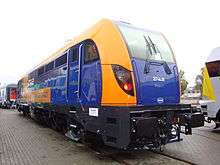Newag Dragon
| Newag Dragon | |
|---|---|
.jpg) | |
| Manufacturer | Newag |
| Number built | 9 |
| Specifications | |
| Maximum speed | 140 km/h (87 mph) |
| Weight | 119 t (117 long tons; 131 short tons) |
| Power output | 5,004 kW (6,710 hp) |
The Newag Dragon is a six-axle electric locomotive, designed to pull carriages with a weight to 4500 tons. The locomotive is built by Newag in Gliwice. Currently a total of nine locomotives have been built, these are in service with freight operators STK and Lotos Kolej.
History

Origin
The main railway freight locomotive in Poland is the six-axle ET22 electric locomotive, which has had over 1000 units built between 1969-1989 in Pafawag company in Wrocław.[1] In later years, the company, which is the main producer of electric locomotives, ceased production of heavy freight locomotives, building only four-axle passenger electric locomotives of the EP09 type(up to 1997), dual-mode EU43 and EU11 locomotive. These two latter, which have been built for the railway between 1997 and 2002 after the acquisition of Pafawag by Adtranz, did not make it to Poland due to financial problems when ordering the locomotives. In 2002, Adtranz-Pafawag was acquired by Bombardier, which decided not to produce an electric locomotive in Wrocław. Since 2002, for several years in Poland there had been no electric locomotives produced.[2]
Prototype production
In September 2006, an agreement was signed with the Ministry of Science and Higher Education for funding the project to build a new locomotive. It was decided to produce a train dedicated for heavy freight, and in addition, the company wanted to allow operation on a wider variety of tracks therefore the locomotive was to be six-axle.[3] The project for the locomotive was prepared in cooperation with the EC manufacturer and the Institute of Electrical Engineering. The traction engines are designed by the Research and Development Centre of Electrical Machines Komel[4] and built by the Department of Electrical Machines Emit.[5]
Presentations and tests
.jpg)
On 13 January to 30 December 2011 the supervised operation prototype unit, was led by STK, PKP Cargo, Pol-Miedz Trans and Lotos Kolej, under which E6ACT-001 altogether has driven up to 77 866 km, and the maximum train weight was 4 021 t. In October, the locomotive was re-launched at Trako Trade Fair in Gdańsk. On the 23 December the Railway Transport Office issued a perpetual license for the service of the locomotive. In February 2012, a promotional operation was took by DB Schenker Rail Poland.[6] In September 2014 at the InnoTrans Trade Fair presented the locomotive belonging to the Lotos Kolej with the E6ACT-008 series.[7]
Orders
- 12 October 2011 - signed a contract for the supply of 4 locomotives E6ACT for STK
- 19 September 2012 - signed a contract for the supply of 5 locomotives E6ACT for Lotos Kolej
- 30 January 2015 - signed a contract for the supply of 5 locomotives E6DCF-DP for Freightliner PL, leased via ING Lease, later name changed for E6ACT-d
Construction
Available versions
The locomotives are available in versions powered by:
- DC voltage of 3 kV (type E6DCU originally E6ACT).
- AC voltage of 15 or 25 kV (type E6ACU).
- DC voltage of 3 kV and AC voltage of 15 or 25 kV (type E6MSU).
- Diesel (version with limited power including continuous traction power with the maximum speed of the load). However, the company produced the locomotives powered by DC with the E6ACT series.[8]
The manufacturer also provides 2 options for improvement:
- Max load - increasing the traction force to 450 kN.
- Dual power - with an additional combustion engine.[9]
E6ACT
.jpg)
Power Supply
The E6ACT locomotive is designed to operate at a supply voltage of 3 kV DC. The locomotive traction has IGBT technology. The first unit of the locomotive is powered by 6 STX500-4A electric engines with a capacity of 834 kW each, which is powered by traction converters developed by the Institute of Electrical Engineering. The gear axle SET 553 is supplied by Voith. The locomotives are equipped with disc brakes.[10]
Possibilities
The E6ACT/E6ACU locomotive has a continuous power of 5,004 MW and a starting tractive effort of 375 kN, maing it able to pull 4,000 tonnes of cargo - or 4,500 with Max Load option.[11]
References
- ↑ "The first Polish locomotive in nineteen years". Inforail. Retrieved 16 December 2014.
- ↑ "The Dragon Locomotive by Newag" (PDF). Bambus. Retrieved 16 December 2014.
- ↑ "The Birth of the Newag Dragon". Kurier Kolejowy. Retrieved 16 December 2014.
- ↑ "KOMEL Katowice Locomotive by Newag". KOMEL. Retrieved 16 December 2014.
- ↑ "Poland begins a new journey in producing locomotives". Wyborcza. Retrieved 16 December 2014.
- ↑ "The presentation of the new locomotive". Rynek Kolejowy. Retrieved 16 December 2014.
- ↑ "Three work stage on the engine" (PDF). Cantoni Group. Retrieved 16 December 2014.
- ↑ "The progress in producing the types". Railvolution. Retrieved 16 December 2014.
- ↑ "Trains and platforms". Kurier Kolejowy. Retrieved 16 December 2014.
- ↑ "Engineering Specification of the Newag Dragon Series". Kurier Kolehojy. Retrieved 16 December 2014.
- ↑ "Successful tests of the train". Inforail. Retrieved 16 December 2014.